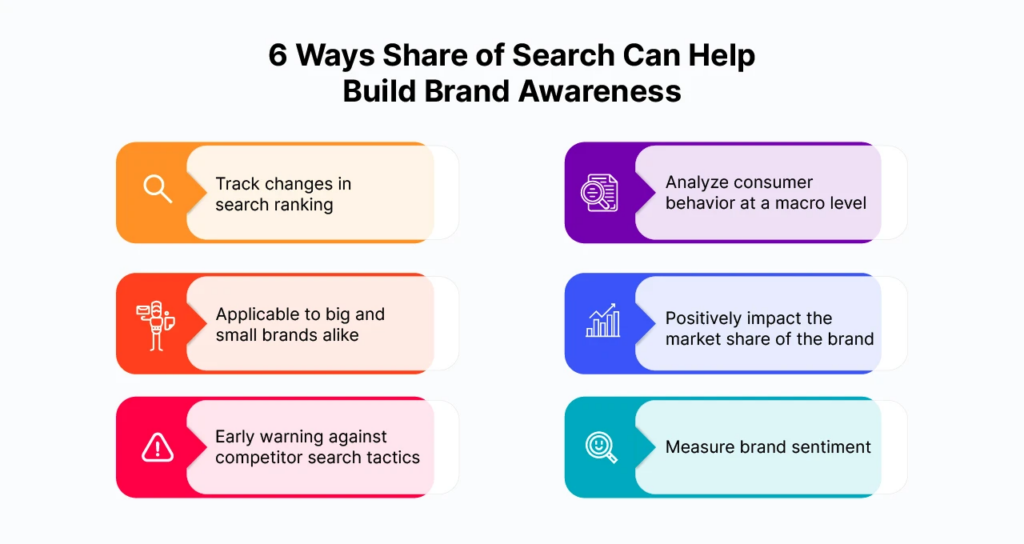What is Share of Search?
Share of Search refers to the proportion of search query volume related to a brand or product against the total search volume for all related keywords within the same industry or category.
It indicates brand visibility, consumer interest, and market position, offering a more nuanced understanding of a brand’s online presence compared to traditional metrics like click-through rates or page views.
Why Share of Search Matters in 2024
- Predictive Power: Share of Search has been identified as a leading indicator of market share movements. A rise in the Share of Search often precedes an increase in sales and market share, making it a valuable metric for forecasting and strategic planning.
- Brand Health Indicator: SoS reflects the health of a brand in the digital ecosystem. A stable or growing signals strong brand health and consumer interest, while a decline may indicate emerging challenges.
- Competitive Benchmarking: By analyzing the businesses can benchmark their performance against competitors, identifying strengths, weaknesses, and opportunities for growth in their digital strategy.
- Cost-Effective: Unlike many digital marketing metrics, calculating SoS doesn’t require substantial investment in tools or technologies. With access to search query data, businesses can derive meaningful insights without significant costs.

Image Source: Calculating Share of Search | 42Signals
Why Share of Search is the Key Metric in 2024

Image Source: Biotique’s Share of Search | 42Signals
By being one of the most important methods of gaining customer visibility can make or break brands. Most users, don’t scroll past the first page on any of the platforms – be it search engines or even online marketplaces like Amazon. That’s why it’s crucial to have products visible on the first page and for brands to optimize every aspect of their product interface to gain those prime positions. Here are a few ways to get you started –
- Optimized Product Listings: Ensure your product listings are fully optimized with relevant keywords, high-quality images, and detailed descriptions that match consumer search queries.
- Leveraging Reviews and Ratings: Encourage satisfied customers to leave positive reviews and ratings, as these can influence your product’s visibility and appeal in search results. The key here is to not buy or post fake reviews but have real people post their authentic thoughts. Too many positive reviews with almost zero negatives can also be a telltale sign to identify phoney reviews.
- Inventory and Pricing Strategy: Maintain competitive pricing and ensure adequate inventory levels to capitalize on increased search visibility and avoid stockouts during peak demand. An inventory management tool can be extremely useful here, especially for a larger product base.
- Data-Driven Insights: Brands must also regularly analyze platform-specific analytics to understand their brand’s performance, identify trends, and adjust their strategies accordingly. Analyze spikes and declines to understand brand performance over time.
- Keyword Selection: Identify a comprehensive list of keywords relevant to your brand and industry. This should include brand-specific terms, product names, and generic terms related to your offerings.
- Benchmarking: Compare your SoS against competitors to gauge your market position and identify areas for improvement or investment. These insights can then inform marketing strategies, content creation and other initiatives.
Conclusion
As e-commerce continues to evolve, mastering platforms like Amazon and Flipkart is essential for brands looking to secure a competitive edge in 2024. The strategies outlined above offer a roadmap for leveraging SoS effectively, for businesses looking to improve their sales and visibility online.
Frequently Asked Questions
What does share of search mean?
Share of search refers to the percentage of total searches for a particular keyword or set of keywords that are performed on a specific search engine. It represents the proportion of search traffic that a particular platform receives for a given query. For example, if a search engine has a 50% for the term “best restaurants in New York City,” it means that half of all searches for that term were performed on that particular search engine.
What is an example of a share of search?
An example of a Google’s share of search for the term “COVID-19 vaccine.” According to recent data, Google accounts for approximately 80% of all searches for this term, meaning that 8 out of every 10 searches for information about COVID-19 vaccines are performed on Google.
What is the formula for share of search?
The formula for calculating is relatively simple:
Share of Search = (Number of searches on a specific search engine / Total number of searches) x 100
For example, let’s say we want to calculate the share of search for Bing for the term “best laptops under $500.” If Bing received 10,000 searches for that term and the total number of searches across all search engines was 100,000, we could calculate Bing’s share of search as follows:
Share of Search = (10,000 / 100,000) x 100 = 10%
This means that Bing accounted for 10% of all searches for “best laptops under $500.




